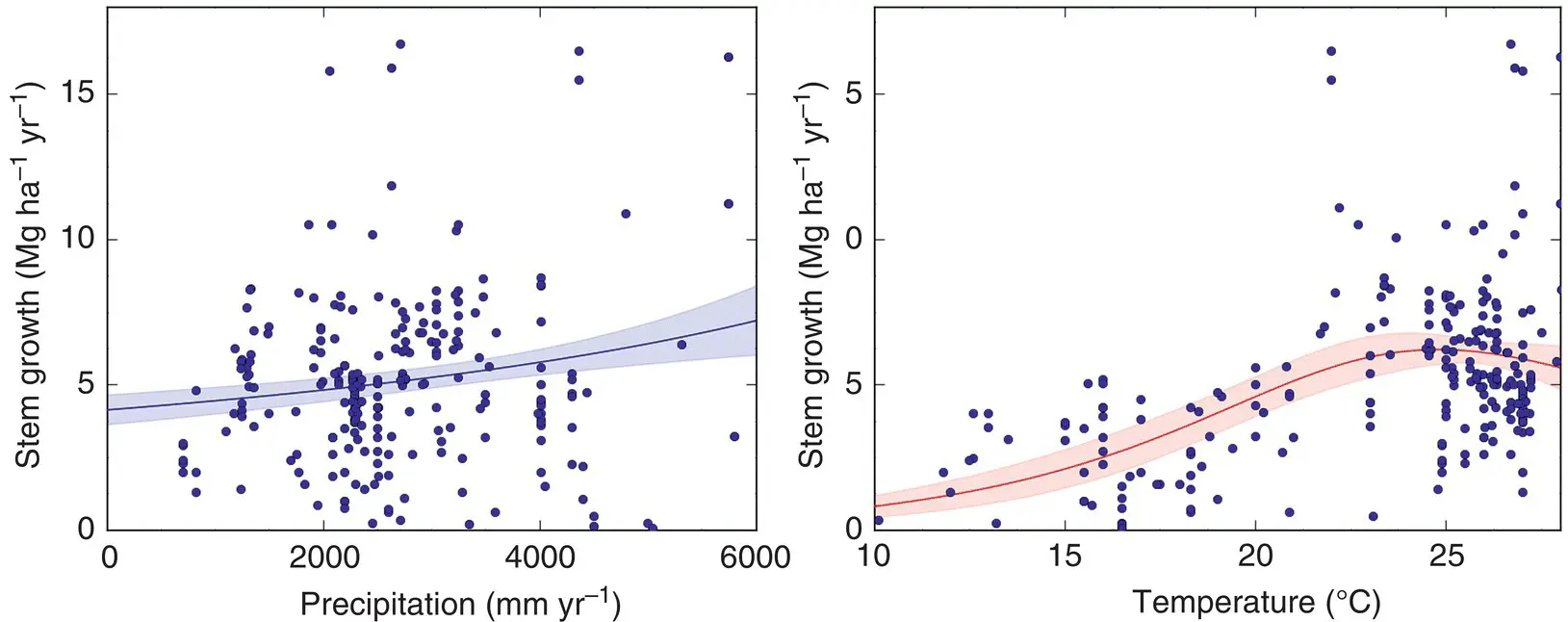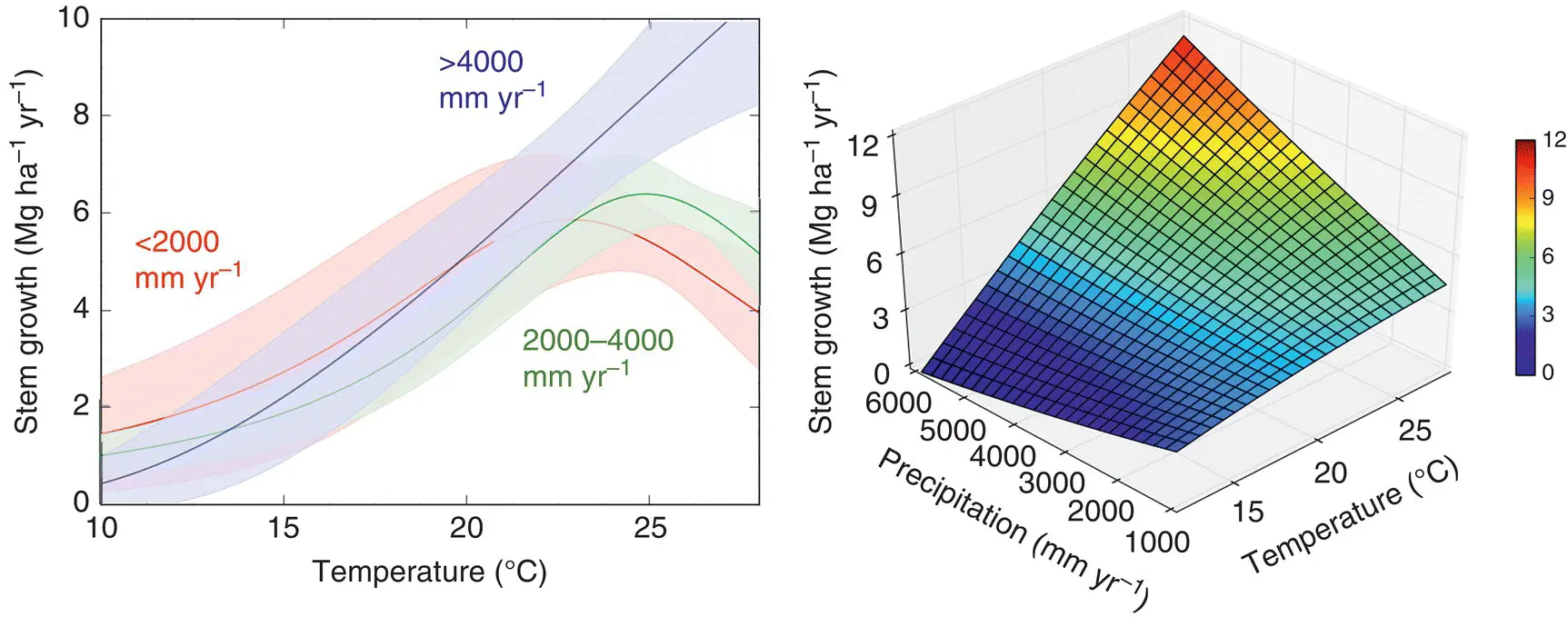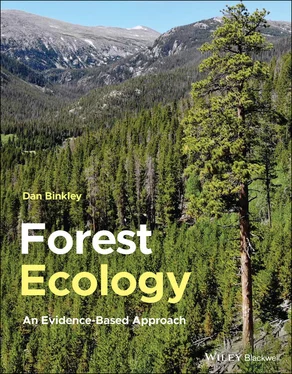Dan Binkley - Forest Ecology
Здесь есть возможность читать онлайн «Dan Binkley - Forest Ecology» — ознакомительный отрывок электронной книги совершенно бесплатно, а после прочтения отрывка купить полную версию. В некоторых случаях можно слушать аудио, скачать через торрент в формате fb2 и присутствует краткое содержание. Жанр: unrecognised, на английском языке. Описание произведения, (предисловие) а так же отзывы посетителей доступны на портале библиотеки ЛибКат.
- Название:Forest Ecology
- Автор:
- Жанр:
- Год:неизвестен
- ISBN:нет данных
- Рейтинг книги:5 / 5. Голосов: 1
-
Избранное:Добавить в избранное
- Отзывы:
-
Ваша оценка:
- 100
- 1
- 2
- 3
- 4
- 5
Forest Ecology: краткое содержание, описание и аннотация
Предлагаем к чтению аннотацию, описание, краткое содержание или предисловие (зависит от того, что написал сам автор книги «Forest Ecology»). Если вы не нашли необходимую информацию о книге — напишите в комментариях, мы постараемся отыскать её.
Forest Ecology
An Evidence-Based Approach Forest Ecology: An Evidence-Based Approach
Forest Ecology: An Evidence-Based Approach
Forest Ecology — читать онлайн ознакомительный отрывок
Ниже представлен текст книги, разбитый по страницам. Система сохранения места последней прочитанной страницы, позволяет с удобством читать онлайн бесплатно книгу «Forest Ecology», без необходимости каждый раз заново искать на чём Вы остановились. Поставьте закладку, и сможете в любой момент перейти на страницу, на которой закончили чтение.
Интервал:
Закладка:
The core framework is structured by three simple questions. “What's up with this forest?” leads to familiar methods of measurement. “How did the forest get that way?” can be investigated with a variety of approaches for finding and interpreting historical evidence. “What's comes next?” usually can have only fuzzy answers because the future is not yet written for forests.
This set of core framework questions leads to a second trio of method‐related questions that develop the necessary details to answer the core questions.
1 What is the central tendency (or mean) for this set of objects? (The set could be trees in this forest, forests across this landscape, or the forests at this location across millennia.)
2 How much variation occurs around that central tendency? (Do all trees increase in growth rate across all ages, or do some decline?)
3 What factors help explain when cases fall above (or below) the central tendency? (Are suppressed trees likely to decline in growth rate while large trees continue to increase?)
The core framework and core method may seem a bit awkward or unclear, but they should become clearer (and more useful) as the book uses them to investigate how forests work.
A Picture May Be Worth 1000 Words, But a Graph Can Be Worth Even More
A graph is full of answers, and the only work a reader needs to do is to bring the right questions, and know how to interrogate the graph. A good place to start exploring a graph is to apply a few questions:
1 What exactly does the horizontal X axis represent?
2 What exactly does the vertical Y axis represent?
3 When X increases, what happens to Y?
Reading information from graphs becomes easier with practice, and a few points about the graphs in this book might be helpful. Some of the points are obvious, but others will take some thought before insights can be pulled out of graphs.
The graphs in Figures Band Ccome from a massive dataset for tropical forests around the world. Taylor et al. (2017) compiled information on rates of wood growth, with basic information on each location's annual precipitation and average temperature (this example shows up again in Chapter 2). We know that trees need large amounts of water, because water evaporates (transpires) from leaves as the leaves absorb carbon dioxide from the air. We might have an idea that forests with a higher water supply should grow faster. This idea may or may not be true for forests, so checking the evidence from many studies lets us determine if this idea is worthy of our confidence. Indeed, forests with the highest amounts of precipitation grew more stemwood than those with a moderate supply. A few key features are worth pointing out. The X axis for precipitation spans a sevenfold range, from 1000–6000 mm yr −1. The Y axis for stem growth also spans a large range, but the line in the graph goes only from a bit more than 4 Mg ha −1yr −1to something less than 8 Mg ha −1yr −1. Note that a sixfold change in the X axis (precipitation) gives at most a twofold range in stem growth, so the response is not as dramatic as if a twofold difference in precipitation gave a sixfold change in stem growth. Water matters, but not as much as we might have expected.

FIGURE B Stem growth in tropical forests is higher for sites with higher precipitation (left). The association with temperature is more complex, increasing at low temperatures and declining at the highest temperatures
( Source:from data in Taylor et al. 2017).

FIGURE C The influence of both factors can be examined together by examining the response of growth to temperature for three precipitation groupings (lower left). Putting sites into precipitation groups leaves out some of the information in the full dataset, and a 3D graph makes use of all the information. 3D graphs can work well for illustrating the overall trend surface, but specific details may be easier to read on 2D graphs
( Source:from the database compiled by Taylor et al. 2017).
A second point for the first graph is that the average across all the studies follows a simple trend: a given increase in precipitation gives about the same amount of increase in stem growth, regardless of whether we look at the dry end or the wet end of the spectrum. We might have guessed that a small increase in water for dry sites would have a bigger value for tree growth than the same increase on a site that is already wet, but the available evidence would not support that generalization.
Just because the line in a graph goes up does not mean the trend warrants high confidence. If we chose a set of three numbers at random, the odds are good that the average trend would go up or down, rather than be flat. But if we choose a set with 100 random numbers, the odds are very high indeed that the trend would be flat (as there was no chance of the value of Y being related to X). This third point is illustrated with the shaded band around the line in the first graph, which represents the 95% confidence interval around the line. This means the evidence says the true trend would fall within that band about 95% of the time if the sampling were repeated. If we plotted a line with 240 random points for stem growth for random levels of precipitation, the line would be close to flat. If a flat line was placed into Figure B, it would fall outside the shaded bands of the confidence interval, so high confidence is warranted that sites with high rates of forest growth also tend to have higher precipitation. The odds are less than one in one thousand that growth and precipitation are unrelated (a flat line; this is the “P” value in statistics, which was <0.001 for this trend). This relationship of course does not prove that having more water is the key to producing more growth, but it does show the idea is not counter to the available evidence.
A third point about the first graph is that the dispersion of points around the line is broad indeed. Two tropical forests that have the same amount of precipitation might easily differ by twofold in growth rates. Even if confidence had been warranted in an average effect of precipitation, the average trend would not give a strong prediction for any single observation: half of all observations are always above average, and half below, no matter how much confidence is warranted in the overall trend.
This dispersion of points around the average trend is the fourth important story in the first graph. In statistics, the dispersion is the variance of the sample, and a number is often applied to trends in graphs that characterizes this dispersion around the average. The correlation coefficient (r) describes how tightly the data clump near the average trend, and the square of the correlation coefficient (r 2) tells the proportion of all the variability in Y values that relates to the level of the X values. In the first graph, the r 2for stem growth in relation to precipitation is 0.04 (4%). We can be strongly confident that stem growth on average increases with precipitation, but that knowledge accounts for only a very small part of the full distribution of growth rates of tropical forests. The idea seems likely to be true, but it gives very little power for precise predictions.
The second graph in Figure Bshows the growth rates of the same forests, but in relation to the average annual temperature. The confidence band is a bit tighter in this case, and the dispersion of points around the trend is not as large. The probability that random noise would account for the pattern is quite small (less than one in a thousand), so high confidence is warranted in the association between stem growth and temperature. The average trend with temperature accounts for about 23% of all the variation in growth rates among sites (r 2= 0.23). Does higher temperature directly cause higher growth rates of forests? Possibly, but the association between two things does not mean that one causes the other. It's possible that soil nutrient supply is the real driver of growth, and soils in warmer parts of the Tropics have higher nutrient supplies. Confidence in whether one thing actually drives another depends on further evidence (and often direct experimentation).
Читать дальшеИнтервал:
Закладка:
Похожие книги на «Forest Ecology»
Представляем Вашему вниманию похожие книги на «Forest Ecology» списком для выбора. Мы отобрали схожую по названию и смыслу литературу в надежде предоставить читателям больше вариантов отыскать новые, интересные, ещё непрочитанные произведения.
Обсуждение, отзывы о книге «Forest Ecology» и просто собственные мнения читателей. Оставьте ваши комментарии, напишите, что Вы думаете о произведении, его смысле или главных героях. Укажите что конкретно понравилось, а что нет, и почему Вы так считаете.












